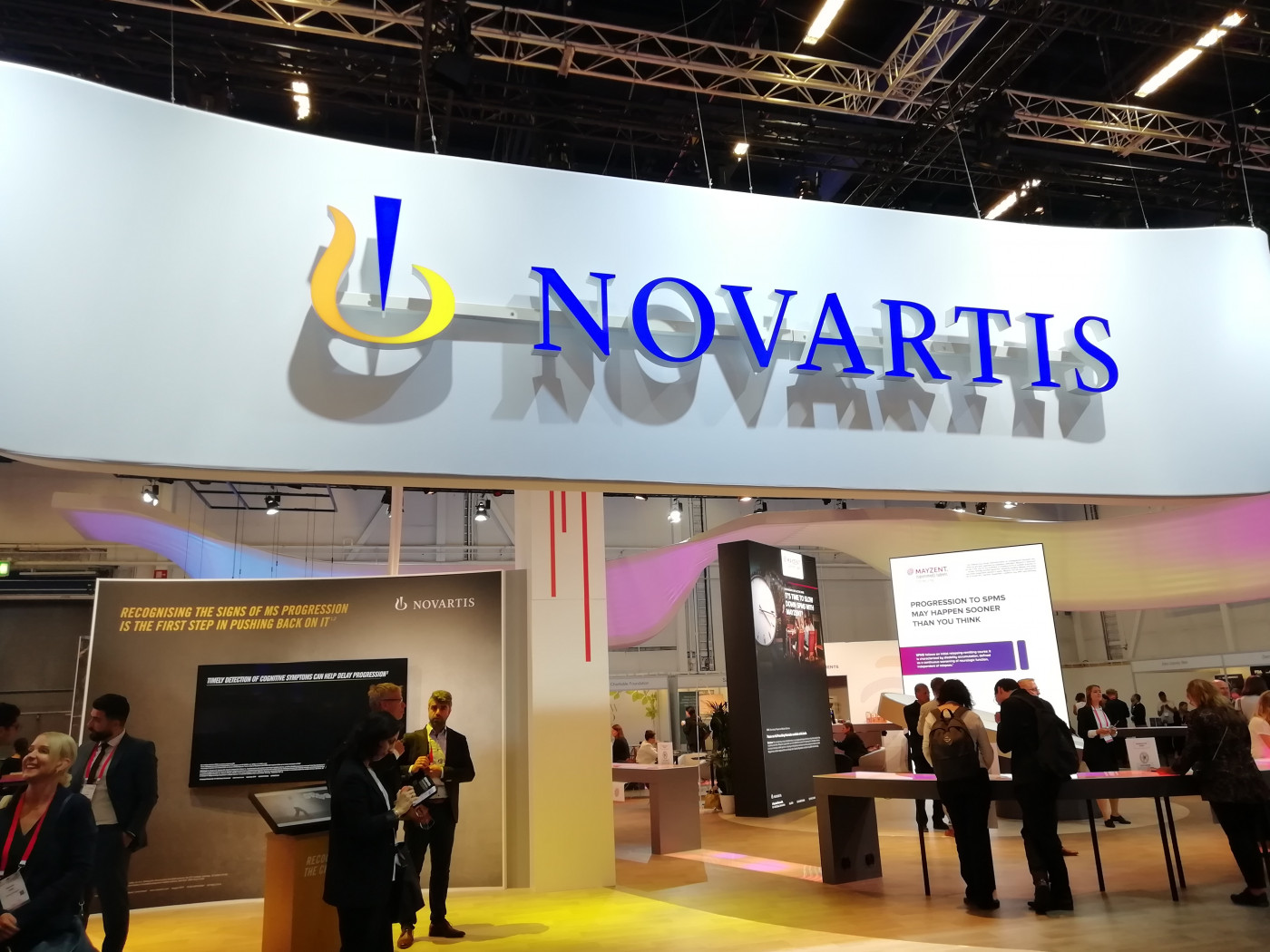#ECTRIMS2019 — Ofatumumab Superior to Aubagio in Lowering Relapse Rates and Lesions, Data Show
Written by |

#ECTRIMS2019
Monthly under-the-skin injections of ofatumumab are superior to Aubagio (teriflunomide) to treat relapsing-remitting multiple sclerosis (RRMS) and secondary progressive multiple sclerosis (SPMS), leading to over 50% reduction in relapse rates, and more than a 90% reduction in active brain lesions, compared with Aubagio, results from ASCLEPIOS I and II trials show.
Ofatumumab may represent a highly effective, more convenient treatment option that can be administered by patients at home, and seems to parallel Ocrevus (ocrelizumab) infusions in terms of efficacy. But a deeper analysis is needed to establish such a comparison, the researchers noted.
Novartis, the owner of ofatumumab’s development and marketing rights, plans to submit a marketing application to health authorities by the end of this year.
The data was presented by Stephen L. Hauser, MD, director of the University of California, San Francisco (UCSF) Weill Institute for Neurosciences, at the 35th Congress of the European Committee for Treatment and Research in Multiple Sclerosis (ECTRIMS), held Sept. 11-13 in Stockholm.
Hauser’s presentation was titled, “Efficacy and safety of ofatumumab versus teriflunomide in relapsing multiple sclerosis: results of the phase 3 ASCLEPIOS I and II trials.”
Ofatumumab is the first fully human monoclonal antibody against CD20 — a marker present on immune B cells, which are involved in MS development. The therapy is under development as a self-administered, once-monthly 20 mg injection under the skin.
The therapy works by binding to the CD20 protein found on the surface of certain B cells, “resulting in B-cell depletion, and reduced B- and T-cell interactions, which may reduce inflammation in the central nervous system,” Hauser said.
This mechanism of action is identical to that of Ocrevus (an approved MS therapy) and rituximab (a therapy used off-label in MS).
Under the brand name Arzerra, ofatumumab is approved by the U.S. Food and Drug Administration (FDA) to treat certain leukemias; clinical trials are underway to test its efficacy for other blood cancers and relapsing MS.
Initially developed by the Danish biotech company Genmab and GlaxoSmithKline (GSK), rights over ofatumumab were acquired by Novartis in 2015.
Twin Phase 3 trials — ASCLEPIOS I (NCT02792218) and II (NCT02792231) — are running in parallel to compare the efficacy and safety of ofatumumab versus Aubagio in adult patients with relapsing MS, including RRMS and active SPMS patients. Both trials are alike in design and dimension.
The ASCLEPIOS trials have been “quite an undertaking, with 385 centers in 37 countries” involved, Hauser said.
A total of 1,882 patients were enrolled (927 in ASCLEPIOS I, and 955 in ASCLEPIOS II), ages 18–55, with no to mild disability (EDSS score of 0–5.5). They also had one of these characteristics: at least one relapse in the past year, at least two relapses in the past two years, or a positive gadolinium-enhancing MRI scan (referring to active lesions) over the year before the trial.
According to Hauser, this study population represents “a typical active MS relapsing population,” with “about 5% of the patients qualifying as having SPMS, and the rest with RRMS. All have very active disease.”
Patients were randomized to receive either ofatumumab 20 mg subcutaneous injections once a month (after an initial regimen on days 1, 7, and 14), or oral Aubagio 14 mg capsules once daily together with placebo subcutaneous injections for up to 30 months (about 2.5 years).
Mean age of patients was approximately 38 years, mean MS duration was eight years, and gadolinium-positive lesions were present in about 40% of the patients. Also, around 60% of the patients enrolled “had been previously treated with other DMTs,” Hauser said, adding that these were mainly injectables.
Results showed that ofatumumab’s efficacy was superior to Aubagio in reducing the annualized relapse rate (the trials’ primary endpoint). Patients treated with ofatumumab had an annualized relapse rate of 0.11 in ASCLEPIOS I and 0.10 in ASCLEPIOS II, compared to rates of 0.22 (ASCLEPIOS I) and 0.25 (ASCLEPIOS II) in the Aubagio group.
In terms of relative reduction (in percentage), there was a “quite impressive, greater than 50% decrease in the annualized relapse rate in ASCLEPIOS I, and 58.5% in ASCLEPIOS II, favoring ofatumumab over [Aubagio]” Hauser said, adding that “these data are highly statistically significant.”
The trials’ secondary endpoints included 3- and 6-month confirmed disability worsening, and results showed that ofatumumab treatment significantly reduced both these parameters — risk reduction of 34.4% at three months, and 32.5% at six months, compared with Aubagio.
“There were risk reductions favoring ofatumumab over teriflunomide in both 3-month and 6-month analysis,” Hauser said.
Another clinical measure assessed was 6-month confirmed disability improvement. Results showed a strong favorable trend for ofatumumab-treated patients to achieve this parameter (an estimated 35.2% increased chance of disability improvement); however, these results “were not statistically significant.”
Regarding MRI data, ofatumumab treatment induced a significant reduction in the number of gadolinium-positive T1 lesions (active areas of inflammation) in the brain, relative to Aubagio.
Ofatumumab led to “a quite stunning” result, Hauser said — a 97.5% relative reduction in the number of T1 lesions in ASCLEPIOS I, and 93.8% in ASCLEPIOS II, compared to Aubagio.
As for new or enlarging T2 lesions, their number also dropped by more than 80% with ofatumumab treatment compared with Aubagio — 82% relative reduction in ASCLEPIOS I, and 84.5% in ASCLEPIOS II.
Although quite significant, such numbers were not as great compared to T1 lesions, Hauser noted, likely due to a “weaning down of disease activity” that happens over the first few weeks or months following treatment initiation.
The team also measured levels of serum neurofilament light chain (NfL), a marker of nerve cell damage. Results showed that ofatumumab-treated patients had a significant and consistent reduction in serum levels of NfL from the third month of treatment onward in both ASCLEPIOS trials. In contrast, NfL levels in the Aubagio-treated group did not show a great decline, Hauser noted.
Although ofatumumab tended to delay brain volume loss, the change between treatment groups was not significant. Hauser emphasized that this result “is not unexpected,” given the fact that previous data showed Aubagio “has a fairly remarkable effect on halting brain volume loss.”
The safety profile of ofatumumab was “quite favorable,” according to Hauser, and in line with that seen in prior Phase 2 data. There were no unexpected safety findings, and the adverse events were balanced between the ofatumumab and Aubagio groups.
Adverse events were seen in 83.6% of patients receiving ofatumumab, and 84.2% of the patients under Aubagio treatment. There were no significant differences in the rate of infections (2.5% ofatumumab vs. 1.8% Aubagio), or malignancies (0.5% ofatumumab vs. 0.3% Aubagio), which were low for both groups.
Hauser concluded that “ofatumumab, with a monthly 20 mg subcutaneous dosing regimen, demonstrated high efficacy and a favorable safety profile.”
When asked about ofatumumab’s advantages and disadvantages compared with Ocrevus, Hauser said: “I think the data will have to speak by itself.” He mentioned that “subcutaneous dosing [of ofatumumab] is an attractive feature, a fully human molecule is an attractive feature. Both [ofatumumab and Ocrevus] have attractive mechanisms of action. I would say that … we are looking at similar efficacy.”
For a definitive answer, “we will have to wait for a deeper dive into the data,” Hauser said.
In Novartis’ press release about the data presented at ECTRIMS, Hauser said: “The results from ASCLEPIOS are wonderful news for patients who would like to take an extremely effective B-cell therapy with low requirement for monitoring, avoiding visits to an infusion center.”
John Tsai, Novartis’ head of global drug development and chief medical officer, said: “Ofatumumab showed high efficacy and a favorable safety profile in people with relapsing MS, offering a potential first B-cell therapy that can be self-administered in the home. This is a big step forward in our relentless efforts to advance and reimagine treatment in the MS journey of each patient.”
The ASCLEPIOS trials were funded by Novartis.





